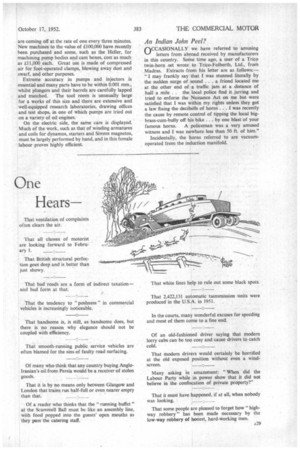Passing Comments
Page 30

Page 31

If you've noticed an error in this article please click here to report it so we can fix it.
Statistics from Sweden
A CCORDING to a recent survey of road vehicles registered in Sweden during 1951, the country had about 410,000 cars, lorries and buses on the roads at the end of last year. This represented an increase of approximately 65 per cent, compared with 1939, the number of lorries rising by 41 per cent., buses by 55 per cent and cars by 89 per cent. The survey also shows the increasing popularity of British; German and Swedish vehicles at the expense of models from the United States.
In 1951 also, imports of finished vehicles at 46,400 compared with 52,500 in 1950 and 30,700 in 1939. Exports of about 5,000 vehicles (including 3,500 lorries and buses) represented increases of 52 per cent. and 28 per cent. over 1950 and 1939 respectively.
Hot Meals by Electric . . .
AN interesting use for battery-electric vehicles has not received much publicity. In connection with hospital catering services, despite the attention paid to dietetics in these institutions, some critic isn has been levelled on the grounds that the food is often cold, and consequently unpalatable. Where the kitchens are near the wards, the solution has been the use of wheeled trolleys with insulated containers, but the difficulty still exists where wards are dispersed
over a wide area. • • Many forms of transport have already been tried, but the use of electric vehicles is becoming almost standard practice, particularly in Scotland. For A28
example, at the Ayrshire Central Hospital, Irvine, there are three N.C.B. vehicles, built by Smiths Electric Vehicles, Ltd., which deliver about 1,500 meals a day. Equipped with 193-amp.-hr. batteries, supplied by the Tudor Accumulator Co., Ltd., they are covering a daily average of 15 miles, including numerous stops. As before the food containers are loaded on to hand trolleys after delivery.
A similar system has been introduced at several Glasgow hospitals, the amount carried varying from 3 tons at the Southern General, to cover about 4,000 meals daily, to a ton at Rob royston. In these cases the daily mileages run from 12-25, mainly over hilly ground with up to 160 stops. Work starts at between 6-7 a.m. and sometimes continues until after 11 p.m., following which the batteries are put on charge, this being automatically controlled and stopped by an M.J.V.
A Visit to Simms MANY expressions of appreciation at the clever LVI design, fine workmanship and excellent machinetool equipment were heard from the party of some 40 members of the London centre of the Institute of Road Transport Engineers during a visit paid on September 17 to the extensive works of Simms Motor Units, Ltd., at Oak Lane, London, N.2.
Large demands for the company's injection pumps have resulted in the need for reorganizing production which, for some types, is on a flow basis with line assembly from a conveyor belt, and complete pumps
are coming off at the rate of one every three minutes. New machines to the value of £100,000 have recently been purchased and some, such as the Heller, for machining pump bodies and cam boxes, cost as much as 111,000 each. Great use is made of compressed air for foot-operated clamps, blowing away dust and swarf, and other purposes.
Extreme accuracy in pumps and injectors is essential and many parts have to be within 0.001 mm., whilst plungers and their barrels are carefully lapped and matched. The tool room is unusually large for a works of this size and there are extensive and well-equipped research laboratories, drawing offices and test shops, in one of which pumps are tried out on a variety of oil engines.
On the electric side, the same care is displayed. Much of the work, such as that of winding armatures and coils for dynamos, starters and Simms magnetos, must be largely performed by hand, and in this female labour proves highly efficient.
An Indian John Peel?
OCCASIONALLY we have referred to amusing letters from abroad received by manufacturers in this country. Some time ago, a user of a Trico twin-horn set wrote to Trico-Folberth, Ltd., from Madras. Extracts from his letter are as follows:— " I may frankly say that I was stunned literally by the sudden surge of sound . . . a friend located me at the other end of a traffic jam at a distance of half a mile . the local police find it jarring and tried to enforse the Nuisance Act on me but were satisfied that I was within my rights unless they got a law fixing the decibells of horns . . I was recently the cause by remote control of tipping the local bigbrass-cum-bully off his bike. . by one blast of your famous horns. A policeman was a very amused witness and I was nowhere less than 50 ft. of him."
Incidentally, the horns referred to are vacuumoperated from the induction manifold.




















































































